The evolution of dogs and a species appropriate diet


Dogs have evolved and differentiated physically quite substantially over time. It is undeniable that a German Shepherd and a Chihuahua look vastly different, but does this mean they are as diverse on the inside? Despite physical characteristics that differentiate one breed of dog from another, dogs and wolves belong to the same genus (Canis) and share 99.9% of their DNA. These similarities can be identified in notable shared characteristics, like digging and foraging, social behaviours and ways of communicating.
When it comes to diet, the jaw structure of canines gives us an indication of the diet that matches their physiology and that they evolved to eat and thrive on in the wild. Dogs’ teeth and jaws are adapted to a carnivorous diet with teeth that are designed for capturing and dismembering prey.
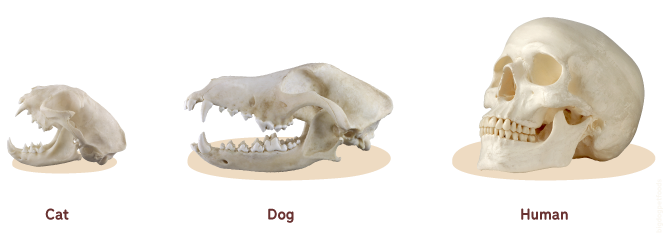
The length and function of the dogs’ digestive system also indicates that they were born to eat raw meat and absorb their nutrition primarily from the body parts of their prey with a small additional component of their diet coming from plant matter which includes grasses, seeds and fruits.
Waste to us, highly nutritious to them
To us humans, some of the more “undesirable” parts of an animal, to canines, are the most delicious and nutritious! In the wild, the first things to go are the internal organs of prey which harbour the most concentrated levels of vitamins and minerals. Organs like liver, kidneys, heart and brain are concentrated sources of fat soluble vitamins like A, D, E and K.
Wolves will consume skin, fur and bones as well as muscle meat in their ancestral diet. In larger prey, the stomach contents may be shaken to remove the bulk of the contents as a natural precautionary instinct, but the lining of the digestive system which is rich in natural probiotics would be consumed.
With all of this in mind, a species appropriate diet takes into account the evolutionary diet of canines and is the modern version of the way our domesticated dogs would eat, if they were still in the wild.
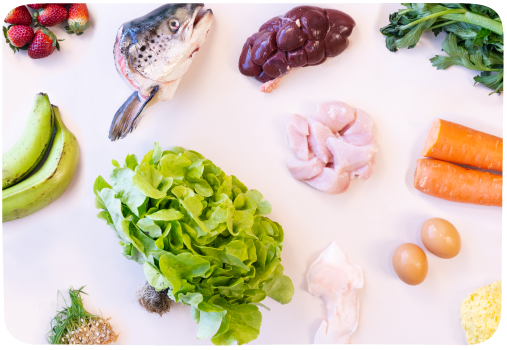
A species appropriate diet is broken down into the following:
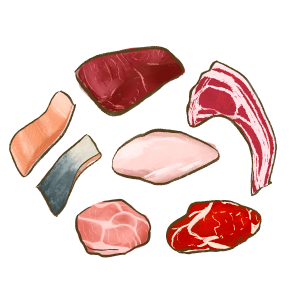
Raw Meat
Raw meat and fats derived from a variety of animals. These provide digestible sources of protein and iron and make up the largest portion of the diet. Protein is the largest source of amino acids which are used as the basic building blocks of cells in the body.
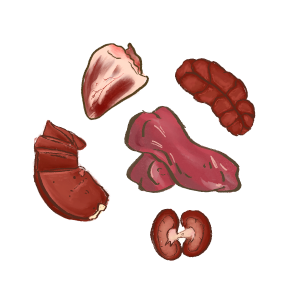
Offal
Organ meat including liver, kidney, heart, spleen and pancreas contain proteins and deliver a plethora of essential vitamins and minerals.
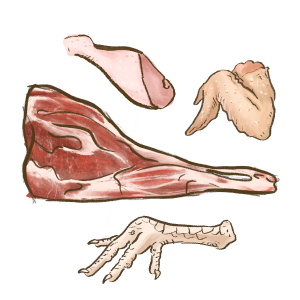
Bone
For concentrated levels of naturally occurring vitamins and minerals, nothing beats soft non-weight-bearing bones and cartilage for a natural source of calcium and phosphorus for teeth and bone health, zinc for immunity and omega-3 essential fatty acids to reduce inflammation.
Plants and Superfoods complete the diet
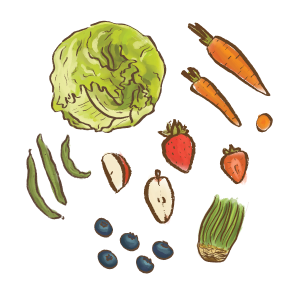
Vegetable and fruit matter
Contain a naturally complete range of vitamins and minerals. Mostly green leafy and coloured vegetables, as well as fruits, ideally crushed and pulp to ensure better absorption. Together these supply antioxidants, phytonutrients, fibre and moisture as well as essential vitamins and minerals.
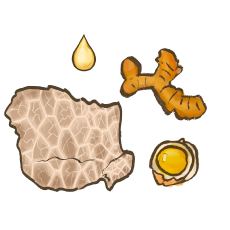
Other
In the wild this would be fur, stomach lining and organs like eyes and reproductive organs. In a modern day version of an evolutionary diet, ingredients like herbs, essential fatty acids, probiotics and prebiotics provide the nutrient profiles of some of these other components without quite so much of the ick factor.
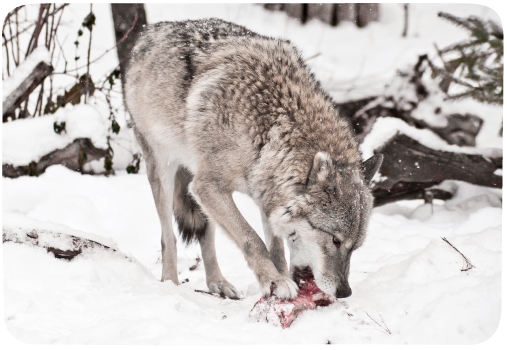
For those who feed a raw evolutionary diet to their pets, it makes sense for a few key reasons:
- Naturally occurring nutrition in percentages and forms that nature intended.
- None of the ingredients in raw evolutionary diets have been damaged or destroyed (also termed de-natured) or adversely affected by cooking so are at their most nutritionally dense, highest quality and therefore beneficial.
- If prepared correctly, nothing synthetic is added to a raw diet as synthetic ingredients have been associated with health problems in pets. This includes synthetic vitamins and minerals which are often required to overcompensate for the nutritional damage caused by cooking foods.
A boost for health and looks
Some of the health benefits associated with an evolutionary diet are:
- Superior joint and bone health
- Strengthened immune system
- Improved skin and softer, shinier coat
- Healthier teeth gums and fresher breath
- Reduced stool volume and odour
- Enhanced reproductive health
- Reduced body odour
- Increased resilience to parasites via enhanced immune function

Some of the concerns when it comes to raw feeding are the presence of pathogens, the quality and source of the ingredients and the processing methods. These concerns are no different to the way we look at the food we, ourselves eat.
Are bacteria problematic?
The number one query when it comes to raw food is, “isn’t there higher levels of bacteria present?” and the answer is yes, absolutely. Unless raw food has been sterilised, which often reduces the nutrient levels as much as the bacterial load, there will most certainly be higher bacterial counts when compared to cooked foods.
Are these bacteria bad? For our pets, no they aren’t. Our pets have shorter digestive systems than we do which are designed for foods to enter and exit quickly, not ferment like in a human digestive system. This reduces the time bacteria can sit in the system, replicate and thrive. Furthermore, pets have highly acidic digestive systems which neutralise bacteria and dissolve bone, therefore more than capable of handling raw food. Even decomposing food poses little risk to our canine friends, often burying bones and food in the yard for a snack a little later on.
Species appropriate feeding made convenient
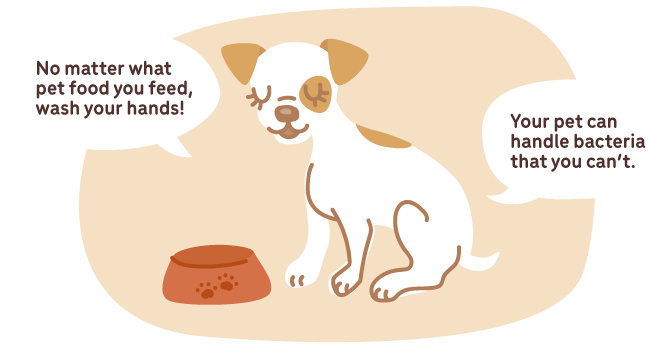
But does the handling of raw pet food increase the risk to our families? No more so than prepping raw food in our own homes before cooking. It is fundamental that when handling any raw food that safe food handling practices are followed, including washing hands, kitchen tools and work-spaces following preparing raw food to ensure the risk of cross-contamination is eliminated.
When it comes to quality and processing of food, if you have the time and ingredient availability, there is no better quality control than your own kitchen. For those of us looking for a more convenient option, ensuring a commercially made raw food diet is comprised of 100% human-grade, Australian ingredients and manufactured in alignment with safe food practices and appropriate industry guidelines is the key to assessing quality.
